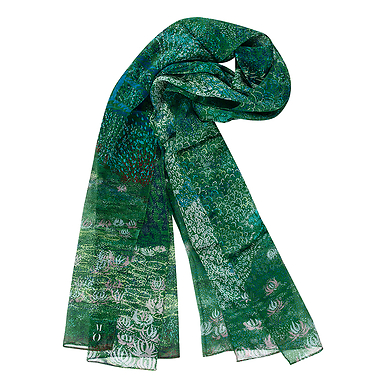Stole Claude Monet - Blue Harmony 60x180 cm
CH100474
This silk Georgette stole, was inspired by Claude Monet's (1840-1926) work, Water Lily Pond, harmony in green, 1899 (Oil on canvas - Paris, Musée d'Orsay).
An achievement both monumental and intimate, Water Lilies are the ultimate expression of Claude Monet's artistic thought. A project on a large scale...
Read more
This silk Georgette stole, was inspired by Claude Monet's (1840-1926) work, Water Lily Pond, harmony in green, 1899 (Oil on canvas - Paris, Musée d'Orsay).
An achievement both monumental and intimate, Water Lilies are the ultimate expression of Claude Monet's artistic thought. A project on a large scale, exploring every variation of light on the water lily pond created by the artist in his garden at Giverny, this series of some 250 works represents a "waterscape" dotted with water lilies, branches of willows and the reflections of trees and clouds. According to Monet these views conjure up "the illusion of an endless all, of waters without a horizon and without a shore."
In 1899 Monet painted no fewer than 12 views of his Japanese bridge in a square format.
A fervent admirer of the art of the Far East, he was doubtless inspired by the collection of Japanese prints that he kept on his walls in his home at Giverny. Each version of the Water Lilies is dominated by a specific harmony of colour, now green, now pink.
This view of the Water Lily Pond, "harmony in green", is distinguished by the composition's symmetry - the water feature is observed here along an axis that runs from east to west - in a picture that is almost square in form. A profound impression of harmony emanates from the green and blue monochrome of the aquatic plants in the little lake, wholly surrounded by lush vegetation.
Close
Login to see prices
Sold by GrandPalaisRmn









